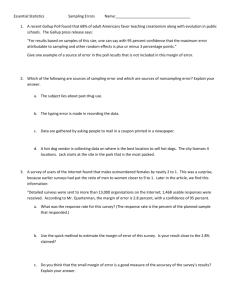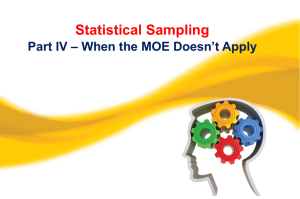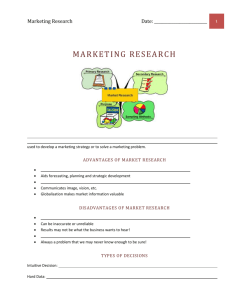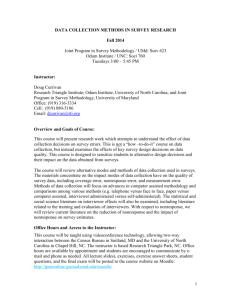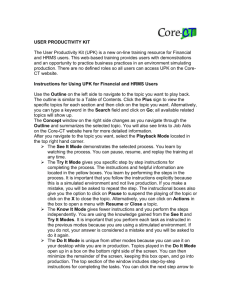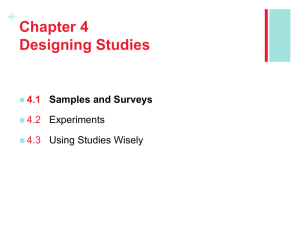Mixed Mode Surveys - on Edith de Leeuw`s homepage!
advertisement
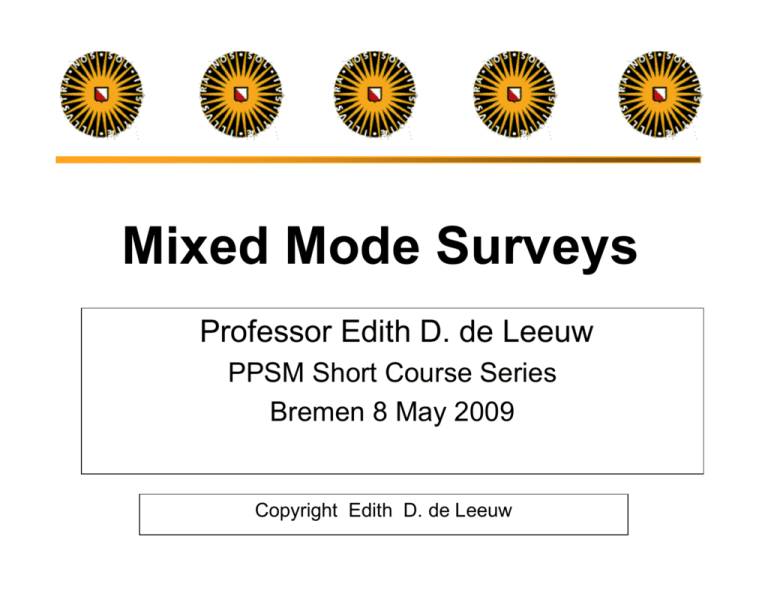
Mixed Mode Surveys
Professor Edith D. de Leeuw
PPSM Short Course Series
Bremen 8 May 2009
Copyright Edith D. de Leeuw
Introduction:
Instructor
Participants
Topic
Instructor
Edith Desiree de Leeuw is a professor of survey
methodology at the Department of Methodology &
Statistics of the University of Utrecht. She is a fellow of
the Netherlands Interuniversities Joint Institute for
Psychometrics and Sociometrics (IOPS), associate editor
of Journal of Official Statistics (JOS) and member of the
editorial board of Sociological Methods and Research,
Field Methods, and MDA. She has edited books on
methodology and statistics, including the recently
published International Handbook of Survey
Methodology, and has more than 20 years experience in
survey research. See also http://www.xs4all.nl/~edithl/
Acknowledgements
Bill Blyth
Don Dillman
Martin Frenkel
Joop Hox
Michael Link
Lars Lyberg
Modes of Data Collection
Respondent Participation Required
Interviewer-administered Modes
Face-to-face interviews (PAPI or CAPI)
Telephone Interviews (PAPI or CATI)
Self-administered
Postal or mail survey
Self-administered with interviewer present
PAPI or CASI
Web or Internet Survey
IVR (Interactive Voice Response)
Modes of Data Collection 2
No respondent participation involved
Enumerator needed
Direct Observation of Behaviour
Counting (e.g., traffic), etc
No enumerator needed
Administrative Records
Scanning, data mining
Electronic Data Exchange (EDI)
TV-usage, ‘people meters’
Participants’ Experience
Hands-on Experience?
Face-to-face interviews (PAPI or CAPI)
Telephone Interviews (PAPI or CATI)
Postal or mail survey
Web or Internet Survey
IVR (Interactive Voice Response)
Mixed Mode Surveys
Mixed Mode Survey
Combine two or more communication modes
Contact
Data collection
Contact
Screening or convincing
ESS allows for appointments made by telephone, Actual
interview face-to-face
Data Collection
Nonresponse follow-up by different method
SAQ-module during face-to-face interview
Web + telephone (PPSM)
A New Trend
“Mixed mode surveys, that is, surveys that combine the use of
telephone, mail, and/or face-to-face interview procedures to
collect data for a single survey project are occurring with
increasing frequency. A second, or in some cases even a
third, method to collect data for a single survey is being used
throughout the world…. Indeed, mixed mode is becoming
one of the survey buzz words of the late 20th century”
Dillman & Tarnai, 1988
Important issues in mixed mode identified by
Dillman & Tarnai are a.o.
Data comparability
Questionnaire construction and pretesting
Mixed-Mode the Norm
“In general, data collection systems do not
consist of one mode only, since mixed-mode
surveys are the norm these days.”
Biemer & Lyberg, 2003
“An
emerging new breed of survey software is
starting to make this
[combine CATI/CAWI]
possible”
Macer, 2004
“Mixed-Mode: The only fitness regime.”
Blyth, 2008
Why Mix Modes?
Increase in Online Surveys
Coverage
Special groups
Response/nonresponse problems
Effort to increase response
Investigating bias
Increase in International Surveys
Different tradition in countries
Different coverage
Mixed Mode Surveys
Which Mode to Choose
Web, telephone, face-to-face, mail?
Which Mix to Chooses
Face-to-face / Telephone
Mail / Telephone?
Internet / Mail?
CATI / CAWI?
???
Why? Consequences?
Terminology
Mixed Mode
Multi Mode
Multiple Mode
Often used interchangeably
Mixed Mode
Any combination of survey data collection
methods (modes)
In any part of the data collection process
Note: Term mixed methods used in qualitative studies
Mixed Mode Surveys
A Road Map
New adventurous continent
Mixed Mode Territory
How to plan the trip
Where to visit?
What to pack?
Short course
Road map
Itinerary
Why Mix Modes?
Total Survey Error
Perspective
Why Mixed-Mode?
Choosing the Optimal Data Collection Method
Best data collection procedure given
Research question
Population
Reduce total survey error
Respect survey ethics/privacy
Within available time
Within available budget
Biemer & Lyberg, 2003
Best Affordable Method
Mixed-mode explicit trade-off
Survey Errors
Costs
Example: Nonresponse follow-up
Mail survey
Telephone follow-up
Face-to-face for sub-sample of remaining
nonrespondents
Costs & Errors
Coverage
Sampling
Costs
Nonresponse
Measurement
Groves, 1989
Survey Errors
Coverage
Sampling
Costs
Nonresponse
Measurement
Coverage Error
Sampling frame must include all units of
population of interest (once), if not:
Frame Coverage Errors
Non-sampling error
Errors arising from construction of
sampling frame
Omissions
Erroneous inclusions
Duplications
Coverage Error and Mode
Sampling frame must include all units of
population of interest (once)
Are all intended covered by mode or is
there danger of undercoverage?
Telephone
Telephone penetration
Landlines vs mobile (cell) phones
Web
Internet penetration differs per country
Web Surveys and Coverage
Mid year 2008
Miniwatts Marketing Group
Europe Diverse Picture
Euro Barometer Data: face-to-face survey!
Internet Access at Home Adults 15 + (2008)
Holland: 86%, Sweden: 83%, Denmark: 81%, Finland:
73%
Germany: 58% overall
Former West Germany: 61%
Former East Germany: 48%
Romania: 11 %, Turkey 15%, Bulgaria 21%
Positive trend over time: Growth 2005 to 2008
Between 1% (Holland) and 21%(Bulgaria0→21%)
10% (UK: 53→63; Estonia 48→58%)
Blyth, May 2008
% Individuals with Internet
Access at Home Slide Blyth, 2008
Source: Eurobarometer 2005 & 2008
100%
90%
80%
70%
60%
2008
50%
2005
40%
30%
20%
10%
0%
EL HU SK LT PT LV
IT
PL CY CZ ES FR IE
AT EE DE SI UK BE LU
FI
DK SE NL
% Individuals with a
Telephone (of any sort)
Source: Eurobarometer 2005 & 2008
100%
90%
80%
70%
60%
50%
40%
30%
20%
10%
0%
CY DK LU EL FI FR UK AT BE DE IE
IT
SI CZ ES EE HU SK LV PT LT PL MT TR MK BG RO
2005
2008
Slide Blyth, 2008
% Individuals with a Mobile
Slide Blyth, 2008
(Cell) Phone
Source: Eurobarometer 2005 & 2008
100%
90%
80%
70%
60%
50%
40%
30%
20%
10%
0%
FI LU CZ DK SI
IE EE IT UK BE AT SK CY ES FR DE LT LV PT HU EL PL MT TR BG MK RO
2005
2008
% Individuals Mobile only
No Fixed (land)line Slide Blyth, 2008
Source: Eurobarometer 2005 & 2008
100%
80%
60%
2008
2005
40%
20%
0%
SE NL LU DE CY UK EL
-20%
SI DK FR IE
PL BE ES AT
IT HU EE PT SK LV CZ
FI
LT
Country Codes
BE Belgium, BG Bulgaria, CZ Czech Rep, DK Denmark
DE Germany, D-W West Germany, D-E East Germany
EE Estonia, EL Greece, ES Spain, FR France
IE Ireland, IT Italy, CY Cyprus, LV Latvia, LT Lithuania
LU Luxemburg, HU Hungary, MT Malta, NL Netherlands
AT Austria, PL Poland, PT Portugal, RO Romania
SI Slovenia, SK Slovakia, FI Finland, SE Sweden
UK United Kingdom, HR Croatia, TR Turkey
Survey Errors
Coverage
Sampling
Costs
Nonresponse
Measurement
Sampling Error
Occurs because only a sample of the
population is invited to participate in a
survey in stead of the total population
Statistic of interest is computed on sample
Provided a probability sample is used
Each element in the population has a known
and non-zero probability of selection from the
sampling frame
Provide protection against selection bias (e.g. selfselection)
Give a means of quantifying sampling error
Sampling Error 2
Statistic of interest is computed on sample
Statistical procedures to accommodate this
Standard error, p-value, statistical tests, etc
Standard software assumes Simple
Random Sampling
But there are more complicated sampling
schemes (e.g., stratified, cluster)
This needs more complicated statistics
Multilevel analysis, Sudaan, etc
Types of Samples
Information from whole population, that is,
NO sampling: A Census ☺
Probability Sampling
Random selection, random sampling
Allows for statistical theory, inference ☺
Non probability Sampling
Selection probability unknown
No known probabilities of inclusion in sample
No statistical theory
No p-values, no margins of error
Survey Errors
Coverage
Sampling
Costs
Nonresponse
Measurement
Non-response Error
Nonresponse / Missing Data
Inability to obtain data on all
questionnaire items from all persons:
Missing Data
Unit non-response
Whole unit fails to provide data
Sampling unit, data collection unit, or
analysis unit
Non-response Error 2
Quantification (Non) Response Figures
Response Rate, Refusal Rate, etc
Standardization response figures
WWW.AAPOR.ORG section survey methods,
standards and best practice
RDD telephone, in person household, mail and internet
surveys of specifically named persons
WWW.ESOMAR.ORG professional codes and
guidelines for guidelines on internet research including
non response categories that have to be reported
Nonresponse Internationally
International Comparison Official Statistics
Longitudinal data statistical offices around the
world
Internationally nonresponse increased over
time, both noncontact and refusal
Countries differ in overall response rate
In general a negative trend over time
Speed of increasing nonresponse differ from
country to country
Source De Leeuw & De Heer (2002)
From Ineke Stoop, 2005
Non-Response Error 3
Beware Nonresponse Error is more than
nonresponse!
Nonresponse error
I. Nonresponse occurs
II. Respondents and non-respondents differ on variable
of interest (key variable study)
Nonresponse figures as such uninformative
High nonresponse but little or no error (or vice versa)
Need nonresponse studies / diagnostics
Nonresponse Rate vs. Bias
Figure 2. Percentage absolute relative nonresponse bias of 235 respondent means by
nonresponse rate from 30 different methodological studies (Groves, 2006 POQ)
Survey Errors
Coverage
Sampling
Costs
Nonresponse
Measurement
Measurement Error
Measurement Error
Nonsampling error or error of observation.
Measurement errors are associated with the
data collection process itself.
Measurement error occurs when a respondent’s
answer to a question is inaccurate,
In other words when answer departs from the ‘true’
value
Measurement Error 2
Measurement errors are associated with the data
collection process itself
There are three main sources of measurement
error:
Questionnaire
Respondent
Method of data collection
When interviewers are used for data collection,
the interviewer is a fourth source of error
Mixed Mode Surveys
A Solution to Problems
Illustrated with Some
Special Cases
How do Modes Differ?
Practical advantages &
disadvantages
Personal needed, time, equipment, etc
Differences coverage
Differences sampling
Different cost structure
Differences measurement
Known Coverage Problems
Face-to-face coverage:
Available household lists not complete
Need to manually count and list
Telephone coverage:
Households with no telephones
Cell phone only households
No directory of cell phone numbers (country specific)
Number portability and erosion of geographic specificity
Mail coverage:
Depends on good mailing list.
Country specific
Registers or postal lists
Email coverage:
No systematic directory of addresses
Note: general population coverage problems
Solution Web Coverage
Concurrent Mixed Mode
Coverage
Sampling
Costs
Nonresponse
Measurement
Declining Response Rates
Response rates decreasing significantly in the last 20
years.
Decline has occurred for most types of surveys— particularly
telephone and in-person interviews
Evidence of trends for mail surveys not as clear
Web surveys are too new to provide good trend data.
But, in general lower than comparable mail surveys
And other modes
Lozar Manfreda et al, 2008; Shih & Fan,2008
Increase in nonresponse is a global problem
No single or clear explanation for these trends.
Several theories on nonresponse
Nonresponse Solution
Sequential Mixed Mode
Coverage
Sampling
Costs
Nonresponse
Measurement
Sequential Mixed Mode
Sequential
Different modes for successive phases of
interactions (contact phase, data collection
phase, follow-up phase)
Screen or contact by phone,collect data by faceto-face interview
Different modes in sequence during data
collection phase
American Community Survey
Mail, telephone, face-to-face
Balden, 2004
American Community Survey
Sponsor: U.S. Census Bureau
Target population: Households in U.S.
2.9M addresses sampled
Focus: social, housing, & economic characteristics
Frame: Census Master Address File
Modes (sequential):
Mail
Telephone follow-up
In-person follow-up
Field period: 3 months
Response rates: 97.3% (for 2005)
1.9M interviews completed
Frankel & Link, 2007
International Surveys
Concurrent Mixed Mode
Coverage
Sampling
Costs
Nonresponse
Measurement
Concurrent Mixed Mode
Concurrent
Multiple modes are used simultaneously for
data collection: implemented at same time
Asthma awareness study
Invitation postcard offering choice
Establishment and business surveys
Dual frame surveys
International surveys
Balden, 2004
To Mix or Not to Mix
Mixing modes has advantages, but
Will the answers provided by respondents differ
by mode?
Can data that are collected through different
modes be combined in one study?
Cross-sectional?
Longitudinal?
Can data that are collected through different
modes be compared over studies or countries?
Taxonomy of Mixed
Mode Surveys I
Multi(ple) Mode Contacts
Multi Mode Survey Systems
Survey more than data collection
Communication with Respondent
Contact Phase
Pre-notification
Screening
Invitation
PPSM
Data collection
Follow-up
Reminders
Terminology Revisited
Multiple Mode In General
Communication with Respondent
Contact Phase
Pre-notification
Screening/Invitation
Follow-up
Reminders
Mixed Mode
Data collection itself
Data collected with more than one mode
At same time (concurrent)
One after another (sequential)
One Survey System: Multiple
Modes of Communication
Example Nielsen media research
Multiple modes of contact in 7 steps
1.
2.
3.
4.
5.
6.
7.
Pre-recruitment postcard
Recruitment phone call
Advance postcard announcing diary
Diary survey package
Reminder postcard
Reminder phone call
Bennett & Trussel, 2001
Reminder postcard
Trussell & Lavrakas, 2004
Contact Phase
Advance Notification/Screening
Different Mode from Data Collection
Rationale
Effect on Quality
Correct sampling frame
Raise response rate
Enhance legitimacy and
trust
Send incentive in advance
Reduce coverage and
nonresponse error
No threats to measurement if
data collection itself is in
singlesingle mode (= data are
collected with one method only)
Contact Phase
Invitation in Different Mode from
Data Collection Itself
Why?
Reduce coverage and nonresponse error
Effect on measurement
No threats to measurement if data collection itself is in one
single-mode
Telephone invitation for IVR
Nielsen media study: data collection diary
Potential threats if data collection is multiple-mode
Postcard invitation for Web/CATI offering choice of mode to
respondent
Follow-up Phase
Reminder(s) in Different Mode
from Data Collection Itself
Rationale
Effect on Quality
Simple reminder, such as
postcard, short telephone
call, etc has low costs
Raise response rate
Reduce nonresponse
error
If pure reminder (data
collection single-mode)
single
no threats to
measurement
Follow-up Phase
Reminder(s) in Different Mode
from Data Collection Itself + Questions
Rationale
Effect on Quality
Simple reminder, such as
short telephone call, has
low costs
Raise response rate
At low additional cost ask
extra questions
Reduce nonresponse error
If reminder plus additional
questions, then multiplemultiple
mode
Part of data collection
different from main mode
Threat to measurement
In Sum: MM &Contact Phases
Second or third method for interaction with
respondent
No actual data are collected with additional
modes (e.g. only encouraging people to respond)
Data quality enhanced ☺
Generally more costly
More complicated logistics
Second or third mode for data collection too
(e.g., some respondents by one, other by second
mode (mail with telephone follow-up)
Potential threats to data integrity
Taxonomy of Mixed
Mode Surveys II:
Measurement Error
Data Collection Phase
Mixed mode for interaction with respondent in
Contact Phase and Follow-up Phase mostly
Win-Win situation!
More complicated in Data Collection Phase
Threats to data integrity
One big exception: win-win situation in mixing
interview mode with SAQ for sensitive questions
Some questions by one mode, other questions by
another mode, but same procedure for all respondents
E.g. CAPI/CASI
Interviewer guidance for non sensitive questions
More privacy, less social desirability sensitive questions
Implications Mixed Mode
in Data Collection Phase
Potential Risk
Introducing mode effects in data set
Result:
Increasing measurement error
However:
Reduction of other errors
E.g., Coverage / nonresponse
Careful consideration needed
Careful design for optimal mixed mode
Recap Sequential vs. Concurrent
Data Collection Phase
Sequential
Different modes in sequence during data collection
phase
Example: American Community Survey
Mail, telephone, face-to-face
Example: LFS Sweden
Longitudinal face-to-face, telephone
Concurrent
Multiple modes are used simultaneously for data
collection: implemented at same time
Example: Asthma awareness study
Invitation postcard offering choice of modes
Example: Using more private method for sensitive questions
Data Collection Phase:
Concurrent Mixed Mode 1
Multiple modes implemented at same time
For sub set of questions only
Reduce Social Desirability Bias
Sensitive questions in more ‘private’ mode
CAPI - (A)CASI mix
Telephone - IVR (or T-CASI) mix
Face-to-face – paper SAQ mix
Example: US National Survey on Drug Use and Health (NSDUH)
Win-win situation ☺
Warning: Beware of concurrent mixed mode for total
questionnaires when sensitive topics are studied!!!
Different groups get different modes
Data Collection Phase:
Concurrent Mixed Mode 2
Multiple modes implemented at same time
For all questions,
questions full questionnaire, one population
Reducing Coverage Error at reasonable costs
Dual frame sampling
Dangers concurrent mixed-mode
Measurement differences
E.g., social desirability, recency effects
Often, difficult to entangle as (self-)selection and mode effect are
confounded
PPSM: random allocation makes it possible to study mode effects
Reduced coverage error at the price of increased
measurement error
Remember Web Coverage
Concurrent Mixed Mode
Coverage
Sampling
Costs
Nonresponse
Measurement
Data Collection Phase:
Concurrent Mixed Mode 3
Multiple modes implemented at same time
For all questions,
questions full questionnaire
Different populations offered different mode
International Surveys
Regional comparisons
Multiple cultures
Practical considerations
Only way to get data for certain groups/countries
Example ISSP
Danger: measurement error
Population and mode effects confounded
International Surveys
Coverage
Sampling
Costs
Nonresponse
Measurement
Data Collection Phase :
Concurrent Mixed Mode 4
Multiple modes implemented at same time
For all questions,
questions full questionnaire, one population
Respondent is offered choice of mode
Rationale: be client centered in order to reduce
nonresponse and save costs
Dangers
Measurement differences confounded with selfselection groups
Higher nonresponse in household surveys!!!
1-9% Dillman (2008).
More effective in establishment surveys by official statistics
Need more empirical data
Respondents Viewpoint:
Offering A Choice Makes Life More Difficult
Researcher’s viewpoint
Client centered to reduce nonresponse
Respondent friendly, establish good-will
BUT Respondent’s viewpoint is different
More information to read and process
Higher ‘costs’ in social exchange
Increased cognitive burden
Two decisions to make in stead of one
From “will I participate” to “will I participate and what method do I
want to use”
Harder task so simplest thing is opt-out
May concentrate on choice, not on survey
Distracts from message and arguments on why to cooperate
Weakens saliency
Sequential Mixed Mode
Nonresponse Reduction
Sequential mixed-mode approach may be more
effective than giving respondents a choice
Sequential for nonresponse reduction better
than concurrent
But, concurrent a good solution for coverage
problems
Sequential approach for nonresponse reduction
Different modes in sequence during data collection
phase
Example: American Community Survey
Mail, telephone, face-to-face
Data Collection Phase:
Sequential Mixed Mode 1
Multiple modes implemented in sequence one
time period / cross-sectional study
Successful for nonresponse reduction
Inexpensive mode first main mode
More expensive mode as follow-up
Potential measurement error
Beware for using data of sequential mixed mode
for assessment of nonresponse bias
Mode and nonrespondents may be confounded
Ideally assessment of nonresponse bias by small sub
sample same mode
Nonresponse Solution
Sequential Mixed Mode
Coverage
Sampling
Costs
Nonresponse
Measurement
Data Collection Phase:
Sequential Mixed Mode 2
Multiple modes implemented in sequence, one sample
Multiple time points / longitudinal study
Cost reduction and practical considerations
More expensive mode
Selection and screening for panel
Base-line study
Next waves less expensive study
Labor force survey many countries
Face-to-face first wave, later waves telephone
Web panel selection by face-to-face or phone,
Sometimes ABBAB design
A=Mode 1, B=Mode 2
Example NESTOR study on aging Holland
Potential measurement error
Time and mode may be confounded
In Sum Mixing Modes
Data Collection Phase
Some questions by one mode, other questions by another
mode, but the same procedure for all respondents
Sensitive questions by SAQ, rest other mode
Data quality enhanced
☺
Selection and biographics first wave longitudinal/panel by one
mode, next waves other modes
Mostly win-win
Beware of confounding mode vs. time effects longitudinal
Some respondents by one mode, other respondents by
another
Nonrespondents by another mode
Offering choice of mode
Cross-national
Potential threats to data integrity
In Sum: Problems MM
Data Collection Phase
Incomparability
Different subgroups different modes (e.g.
nonresponse follow-up, or telephone survey in
city A, mail survey in city R)
Confounding
Are groups different (more crime in R)
Or is it mode effect (e.g., Soc. Des.)
Different samples, different modes
(e.g.,comparative research, international)
More social isolation in country X than Y or different
survey methods (& associated social desirability)?
In Sum: Types of Mixed Mode
Two major distinctions:
Different contact methods are used in
different survey phases (e.g., recruitment,
screening, questionnaire administration, etc.)
Mostly win-win situation, no threat to
measurement if data collection is done in one
single mode
Different methods used for data collection
Concurrent mixed mode:
Offer two or more modes at same time
Sequential mixed mode
Assign modes sequentially during life of the survey
To Mix is to Design
Mixing data collection modes has
advantages in reducing noncoverage and
nonresponse errors, but
Mixing methods may enhance
measurement errors
So,
I.
Design for Mixed Mode Surveys
Design equivalent questionnaires!
II. If possible, measure potential mode effects
III. Adjust
Diagnosis/Adjustment:
Design for Mix
Build in overlap
Method 1
Method 2
Group X
Main Data
Collection
Some Data
Group Y
Some Data
Main Data
Collection
Why and How Modes Differ
Self-Administered vs. Interviewer-Guided
Visual vs. Aural
Media-related customs
Modes & Measurement
Measurement error occurs when a respondent’s
answer to a question is inaccurate (departs
from the “true” value)
Modes vary in terms of:
Interviewer versus self-administered questionnaires
Interviewer impact
Stimuli / manner in which survey question is conveyed to
respondent (and response is recorded)
Information transmission
Knowledge about mode, usage, social customs
Media related factors
How Modes Differ
Overviews: De Leeuw 1992, 2005 and Dillman & Christian, 2005
Empirical Evidence Interviewer Impact
More social-desirability in interview
E.g., drinking, fraud
More open in self-administered modes
More positive in interview
Less lonely, better health in interview
More acquiescence in interview
Tendency to agree
Easier to agree than disagree with another person
Less missing data/more detailed answers open
questions in interview
In general interviewer probes help
How Modes Differ 2
Empirical Evidence Medium Impact
Few systematic studies (Overviews De Leeuw, 1992,
2005) indicate advantage of self-pacing
Self-administered more consistent answers
SAQ higher psychometric reliability on scales
BUT all Paper SAQ vs. interview!
Internet as medium still different (cf. Krug, 2006)
Multi-tasking
Scanning
Satisficing (close enough in stead of optimal)
Internet as Medium
Empirical Evidence Medium Impact
Hardly any systematic studies
Satisficing (less differentiation in web, Fricker et al, 2005)
Psychological testing
Equivalence when no time pressure (De Leeuw et al, 2003)
Conveying sincerity of purpose and trust more difficult
More research needed on nonresponse
Web on average 11% lower (meta-analysis Lozar Manfreda,
et al, 2008)
Research needed on response to sensitive questions
Influence of SPAM
Trustworthiness web
Panel should have advantage vs. one time web survey
Existing relationship vs one-time
How Modes Differ 3
Information transmission: visual vs aural;
spoken vs written vs typed; question by question
or blocks (page)
Some evidence recency effect in telephone surveys
More often last offered answer category is chosen
Context and order effects less likely in self-administered
(paper) than interview
Overview / segmentation
No empirical studies including web surveys
Visual presentation & design & quality
Growing body of evidence that respondents use all information
including visual cues to decide what answer they are going to
report
Cf Dillman, 2007; Toepoel, 2008; Couper 2009
Good news, but….
Literature reports that there are some
mode difference
Not large
Except for more sensitive questions
But….
All empirical evidence is based on
Well conducted experiments
Controlling/adjusting population differences
Equivalent questions and questionnaires!
Lesson Learned
To minimize mode effects one
should:
Control/adjust for population differences
E.g., More younger, higher educated in
web and more elderly, lower educated
phone
Use equivalent questions and
questionnaires!
Ensure measurement equivalence
Questionnaire Design
Traditional Designs for Specific
Modes and the Implications for
Mixed-Mode Surveys
Traditional Design F2F
Face-to-face: Visual + Aural
Show cards with answer choices
Long lists of answers, long scales with each point labelled
Pictures may be used
Open-ended questions on wide variety of topics
Trained interviewers are carefully instructed to probe in order
to get detailed and complete information
No opinion etc not explicitly offered, but accepted
when given. Interviewers often trained to accept ‘no
answer’ only after a standard ‘probe’
Transitional texts to guide interviewer and respondent
to next block of questions
Traditional Design Tel
Telephone: Aural only
Shorter answer scales (2-5 point scales)
Often only anchored end-points
On a scale from 1 to 5 with 1 being not at all satisfied and 5
being completely satisfied
Visual analogue questions
Imagine a ladder with 7 steps
Imagine a thermometer with a scale from 0 to 100
Unfolding for longer scales
Satisfied, dissatisfied or somewhere in the middle
Completely, mostly, somewhat (dis)satisfied
Traditional Design Tel2
Telephone design
Difference with face-to-face
In general breaking up questions in parts to
accommodate loss of visual channel
Like face-to-face
Open-ended questions and probes
No opinion / no answer not explicitly offered
But is accepted after probe by well-trained interviewer
Traditional Design Postal
Mail survey: Visual only, no interviewer present
In general, no breaking up of questions in parts
But, use longer list of response categories in stead
Fully labelled scales
Check all that apply instead of yes/no answers
Only ‘no answer’ when person skipped question, in
stead of interviewer coded ‘refused, do not know, no
opinion’
Go back and forth: more context available
Use illustrations / visuals
Example Mail vs Telephone
Mail
Is the home in which you live
Owned free & clear
Owned with a mortgage
Rented
Occupied under some arrangement
Telephone
Do you own or rent a home?
Follow-ups accordingly, e.g. when owns a home
Do you have a mortgage or is it owned free and clear
Dillman & Christian, 2005
Example Face to Face
Face-to-face using show card with response
categories
Is the home in which you live
Owned free & clear
Owned with a mortgage
Rented
Occupied under some arrangement
Or when quick doorstep only aural
Do you own or rent a home?
Follow-ups accordingly, e.g. when owns a home
Do you have a mortgage or is it owned free and clear
Traditional Design Web
Web survey:
Visual only, but audio potential
No interviewer, but intelligent computer system
Many similarities with mail
Differences
More sequential offering of questions
Check all that apply almost standard format
Radio buttons (but…)
Evidence Christian et al (2008) check-all-that apply not optimal
Grids often used for groups of questions
What is best visual design?
Traditional Design Web2
Web survey many similarities with mail plus
some additional features, such as,
Visual only, but audio potential
No interviewer, but intelligent computer system
Also many differences in question design
Special formats
Slider bars
Drop down menus
Open questions influenced by box size, dynamic
space (cf Dillman)
Visual Illustrations
Visual Illustrations are attractive
May motivate respondent
Cover mail survey positive on response (e.g.
Dillman’s work)
Help question/word meaning
BUT: May influence respondent’s answer!!
Example ”How often do you eat out ”
Illustration 1: couple, candlelight, rose in vase
Illustration 2: picture of MacDonald
Visuals/illustrations and their influence (Couper, 2007,2009)
Designing for Mixed-Mode
Two Cases
Naively Mixing Enhances
Measurement Errors
Different modes have a tradition of different
formats, and question format has effect on
response distribution
Consequence: Designers may routinely
enhance unwanted mode effects in mixedmode survey
E.g. unfolding in one mode, full presentation of all
response options in other mode
What to do?
Design Questionnaire for Mixed-Mode
How?
Design for Mix
Two Situations:
One main method that accommodates the
survey situation best
Main method is used to maximum potential
Other methods auxiliary
Example: Nonresponse follow-up
Truly multiple mode design
All modes are equally important
Example: PPSM, International surveys, Longitudinal
studies, Respondent is offered choice
Design for Optimal Mix 1
One Main Method, other methods auxiliary (cf
Biemer&Lyberg 2003)
Identify main method
Use main method optimal and to its maximum
potential
Auxiliary methods designed equivalent
To avoid measurement error
May be perhaps sub-optimal for auxiliary method
Example: less response categories
Note: Dillman et al (2009) coined this ‘modeenhancement-construction’
Example LFS
Longitudinal face-to-face & telephone
Identify main method
Main method not necessary first method
Main method telephone
Face-to-face auxiliary from longitudinal point of
view
Main design for telephone interview
cf. Biemer & Lyberg, 2003
Example LFS cont
Design longitudinal questions for telephone use
Not full potential face-to-face used in face-to-face
interview
No visuals, no show cards
Shorter scales, unfolding
Open questions
Design one-time recruitment questions for faceto-face use (full potential visual)
Ensure data integrity for longitudinal use!
One Main Method
Telephone with Face-to-Face Mixes
If telephone main method
Relatively easy to design mix optimally
Interviewer assistance in both modes
Do not use the ‘extra’ visual channel in face-to-face
If face-to-face main method
Absence of visuals makes it more complicated
Carefully balance pro and cons
Optimize for one? (preferred-mode specific design, aka modeenhancement construction)
Or use ‘uni-mode’ design?
Implement a small experiment within one mode if possible!
One Main Method 2
Self-Administered Questionnaires and
Interviewer Mixes
SAQ or Interview Main Method?
Complexity of questionnaire
Big issue in mixes with paper-mail not in mixes interview with web
Are visuals essential?
Face-to-face in mix may accommodate visuals, phone does not
CAWI-CATI may have problems, CAWI-CAPI not
Sensitive questions
Social desirability differences, interviewer influence
Is interviewer probing essential or not?
Paper mail problems, but web can emulate some probes
NCES example
Example NCES
RTI surveys for National Center for
Educational Statistics
TSMII-paper Wine et al at www.rti.org
Original studies were done by telephone
Switch to Web with telephone follow-up
Highly Internet savvy population
So web good choice, but…
Example NCES 2
Switch to Web with telephone
follow-up
But, researcher did not want to lose
advantages interviewer
(Non)Response conversion
Clarification, solving inconsistencies,
coding, etc
Blend best features of both modes
Example NCES 3
Start with web survey ‘enriched’
Offer incentive for early completion
Help desk with
Specially trained telephone interviewers
Telephone prompts by phone by trained
interviewers help-desk instead of
standard e-mail reminders
Directly or on answering machine
Reminding of early completion incentive
Example NCES 4
Questionnaire equivalence
Field tested
Some adaptation to web questionnaire
To make situation more equivalent to telephone interview
Changes in web-questionnaire
No answer option equivalence with interview
Continue button in stead of explicit ‘no answer’
But generic pop-up after 3 consecutive no answers to remind of
importance
Key-items redisplayed with tailored text
Sensitive questions and SAQ
Revision finance items to be less sensitive
Help text designed for web also helped interviewers
Truly Multiple Mode Surveys:
Modes are Equivalent
Three Approaches in Design
Modes Are Equivalent
Three schools of thought
Method Maximization
Optimize each mode separately
Unified Mode Design or Uni-mode design
Provide the same stimulus (question format) in each mode,
same offered stimulus
Generalized Mode Design
Purposively constructing questions to be different to achieve
cognitive equivalence, same perceived stimulus
This can be seen as a sophisticated form of mode specific
design (cf Dillman et al 2009)
I. Method Maximization
Optimize each method individually as far as
possible
If one method has an extra use it
Rationale
Reduces overall error
Best of all possible worlds
Assumption
Same concept is measured in both modes but with
different accuracy only
Differences between methods only affect random error!
(no systematic bias)
Reliability and Validity
Imagine an English County Fair and ….
Variance vs Bias or Systematic Error
Low vs. High Reliability
Low vs. High Validity
Method Maximization continued
Optimize each method individually
Beware of Assumptions:
Differences between methods only affect random error!
e1≠ e2
M1: T+e1
M2: T+e2
e1,e2 random
But is this feasible?
How about systematic error, bias?
Danger of question format effects
Example: check al that apply vs.. yes/no
Example: offer all response categories vs unfolding
Burden of proof on designer
II. Unified Mode Design
To minimize data integrity problems Dillman
(2000) proposes UNI-mode design for all modes
Uni-mode design. From unified or uniform
mode design; designing questions and
questionnaires to provide the same stimulus in
all survey modes in order to reduce differences in
the way respondents respond to the survey
questions in the different modes.
Write and present questions the same or almost the
same
Same offered stimulus in each mode
How to do this, see Dillman (2000, 2006)
Uni Mode Design continued
Unified or UNI-mode design for All Modes
Avoid inadvertently changing the basic
question structure across modes in ways that
change the stimulus.
Make all response options the same across
modes and incorporate them into the stem of
the survey question.
Reduce the number of response categories to
achieve mode similarity.
(Dillman 2000, 2006, Chapter 6)
Uni Mode Design cont
Unified or UNI-mode design for all modes
Use the same descriptive labels for response
categories instead of depending on people’s vision to
convey the nature of a scale concept.
Develop equivalent instructions for skip patterns that
are determined by answers to several widely
separated items.
Reverse the order in which categories are listed in
half the questionnaires to avoid recency/primacy
effects
Evaluate interviewer instructions carefully for
unintended response effects and consider their use
for other modes.
(Dillman 2000,2006, Chapter 6)
Uni Mode Design cont
Dillman, 200, 2006, chapter 6:
“Avoid question structures that unfold “
Comment:
Comes from paper mail survey-outlook.
One can and may unfold in both modes in
CAWI-CATI design
Or in CAPI-CATI
Or in … any mix (but not in a mix with PAPI:
paper mail)
Example UNI Mode Design
Mail, Telephone and Face-to-face interview
Early attempt De Leeuw 1992, chap 4, p 37
http://www.xs4all.nl/~edithl/pubs/disseddl.pdf
Response options the same across modes
Same descriptive labels for response categories
Reduced number of response categories
Maximum 7 pushing the limit for phone
But, used show cards in face-to-face
Equivalent with visual presentation mail
Used simple open questions
Interviewer instructions and instructions in mail
questionnaire equivalent
In Sum: Uni-mode Design
Designing for Mixed modes
Unified (uni-) mode questions to reduce mode effects
Question format
Response format
Instruction
Uni-mode design for Mixed modes also implies
Besides questionnaire development
Questionnaire lay-out
Implementation procedures
Meeting the Challenge of
Mixed-Mode Surveys
Unified (uni-) mode questions to reduce
mode effects
Take it one step further, then designing
questionnaire ….
Do not think in traditions.
Example 1: RTI-Wine et all, 2006
Use telephone interviewers after training
for web survey help-desk and for reminders
Do Not Think in Traditions
Example
Question about employment
In CATI split up in two questions
Were you working for either pay or profit during the week of
XXX?
If ‘no’ follow-up question: Were you not working for any of the
following reasons: you were a student on paid work study, you
were self-employed and did not get paid that week, you were
on vacation from work or travelling while employed, you were
on paid sick leave, personal leave or other temporary leave, or
you were on a job that did not pay but had other benefits
Follow-up question was to make sure the respondent counted
these experiences as employment
Do Not Think in Traditions
continued
Question about employment
To improve understanding CATI split up in two
questions
Were you working for either pay or profit during the week of
XXX? + follow-up question
Follow-up question was to make sure the respondent
counted these experiences as employment
Paper/Web traditionally no follow-up question
Paper/Web often incorporate the definition of employed in an
instruction
But people do not read instructions and definitions
carefully
Follow-up questions perhaps be better solution?
Meeting the Challenge of
Mixed-Mode Surveys 2
Step:1 unified (uni-) mode questions to
reduce mode effects
Step 2: Do not think in traditions
Step 3: From unified to an integrated
mode design?
III. Generalized Mode Design
From unified (uni) mode design to an integrated,
generalized mode design
Generalized mode design.
Purposively constructing questions and
questionnaires to be different in different modes with
the goal of achieving cognitive equivalence of the
perceived stimuli, thereby resulting in equivalent
answers across modes.
The same offered stimulus is not necessarily the
same perceived stimulus!
Generalized Mode Design
continued
Prerequisites integrated, generalized
mode design
Designer understands
How differences between modes affect the
question-answer process
How they affect the way respondents perceive the
question, process the information and select and
communicate the response
Designer does not think in traditions
Burden on the researcher to demonstrate that
different questions elicit equivalent responses.
Understand What Happens
To reach cognitive equivalence
Check with respondents, because Medium May
Change Meaning
Same worded question can be perceived differently in
different modes
Wording may be adequate in one medium and awkward in
another
Example Pierzchala et al, 2003
CATI: Are you {name}?
Web: Is your name {name}?
Example
Generalized Mode Design
Christian, Dillman & Smyth (2005)
CATI
When did you start attending WSU, when did you
get your degree, etc
Interviewer probed for desired format
First Web-design
Same question text “When did you start attending
WSU” ,“ When was your degree granted”, etc
With write in standard programming: mmyyyy
Too many errors
Example continued
Generalized Mode Design
In CATI
Interviewer probed for desired format
Interviewer is intelligent system
Web Can Be Intelligent System too!
Try to emulate interviewer
Christian, Dillman & Smyth (2005)
http://survey.sesrc.wsu.edu/dillman/papers/Month%20Year%20Technic
al%20Report.pdf
Redesigned size boxes, graphical language, symbols
Equivalence needed more than the same question wording!
Example continued
Generalized Mode Design
Web Can Be Intelligent System too!
Try to emulate interviewer
Christian et al (2005) redesigned size boxes,
graphical language, symbols
In stead of
Equivalence needed more than the same question
wording
Meeting the Mixed Mode
Challenge Needs Investment
Designing for Mixed modes
Questionnaire construction
Sampling
Embedding small experiments / mode
comparisons
Provide data to estimate mode effect
Using these data for empirically based
adjustment
Weighting
Propensity score adjustment
Embedded Experiments
and/Adjustment
Build in overlap
Method 1
Method 2
Group X
Main Data
Collection
Some Data
Group Y
Some Data
Main Data
Collection
Logistics
Mixed Mode Surveys
Why Mixing Modes?
Balance Costs & Errors
Coverage
Sampling
Costs
Nonresponse
Measurement
Consequences
Mixed Mode Strategy
Coverage
Costs
Nonresponse
Measurement
Sampling
Logistics
Logistics
Need for field reports
Not much literature
But, increasing
E.g., US Bureau of the Census website
Lessons learned
Mixed mode studies
Past mode changes
International studies
Software developers
Emerging experience
Conference papers
E.g., methodological mixed-mode projects UK, Holland, USA
Main Issues
In-House Expertise
Communication
Implementation and Timing
Data Processing
Quality Control
Para information
Cost
Many of these issues well-known in International and
Comparative Research
See for example CSDI International Workshop on Comparative
Survey Design and Implementation &Cross-cultural survey
guidelines at http://ccsg.isr.umich.edu/
Total Quality Approach
Total survey design
Document information
Disseminate information
Information on:
Survey process & quality
Methodologies
Software
Para data
Future
Survey organizations are going to
have to change dramatically in
some ways in order to do
effective surveys as we bring new
technologies online and still use
our other technologies where they
work”
Dillman, 2000
“
Mixed Mode Surveys
Survey research history of changes
Forced by changes in society and
technology
Increased knowledge
Remember first face-to-face interviews
Short & simple questions
Later one of the most flexible methods ☺
Mixed mode has many challenges
We will meet those and learn ☺ ☺ ☺
Suggested Readings
Introduction Mixed-Mode
Edith D. De Leeuw (2005). To mix or not to mix data
collection methods in surveys. JOS, Journal of Official
Statistics, 21,2, 233-255 (also available on
www.jos.nu)
On quality, data collection, writing questions,
online research, mixed-mode, analysis
De Leeuw, Hox & Dillman (2008). International
Handbook of survey Methodology. New York:
Lawrence Erlbaum/Psychology Press, Taylor and
Francis Group
Suggested Websites
Don A. Dillman’s homepage
http://survey.sesrc.wsu.edu/dillman/
Papers
Edith de Leeuw homepage
http://www.xs4all.nl/~edithl/
Additional material and readings accompanying the International
Handbook of survey methodology
University of Michigan-ISR
http://ccsg.isr.umich.edu/
Guidelines for best practice in cross-cultural studies
US Bureau of the Census
http://www.census.gov/srd/mode-guidelines.pdf
Guidelines on developing demographic questions for administration
in different modes
Suggested Websites 2
Journal of Official Statistics
http://www.jos.nu
All articles that appeared in JOS online available, simple
search menu
Survey Practice (AAPOR)
http://www.surveypractice.org
Short practical articles
Autumn 2009, theme propensity score adjustment
European Survey Research Association
http://www.surveymethodology.eu/journal/
Online journal on survey methodology
